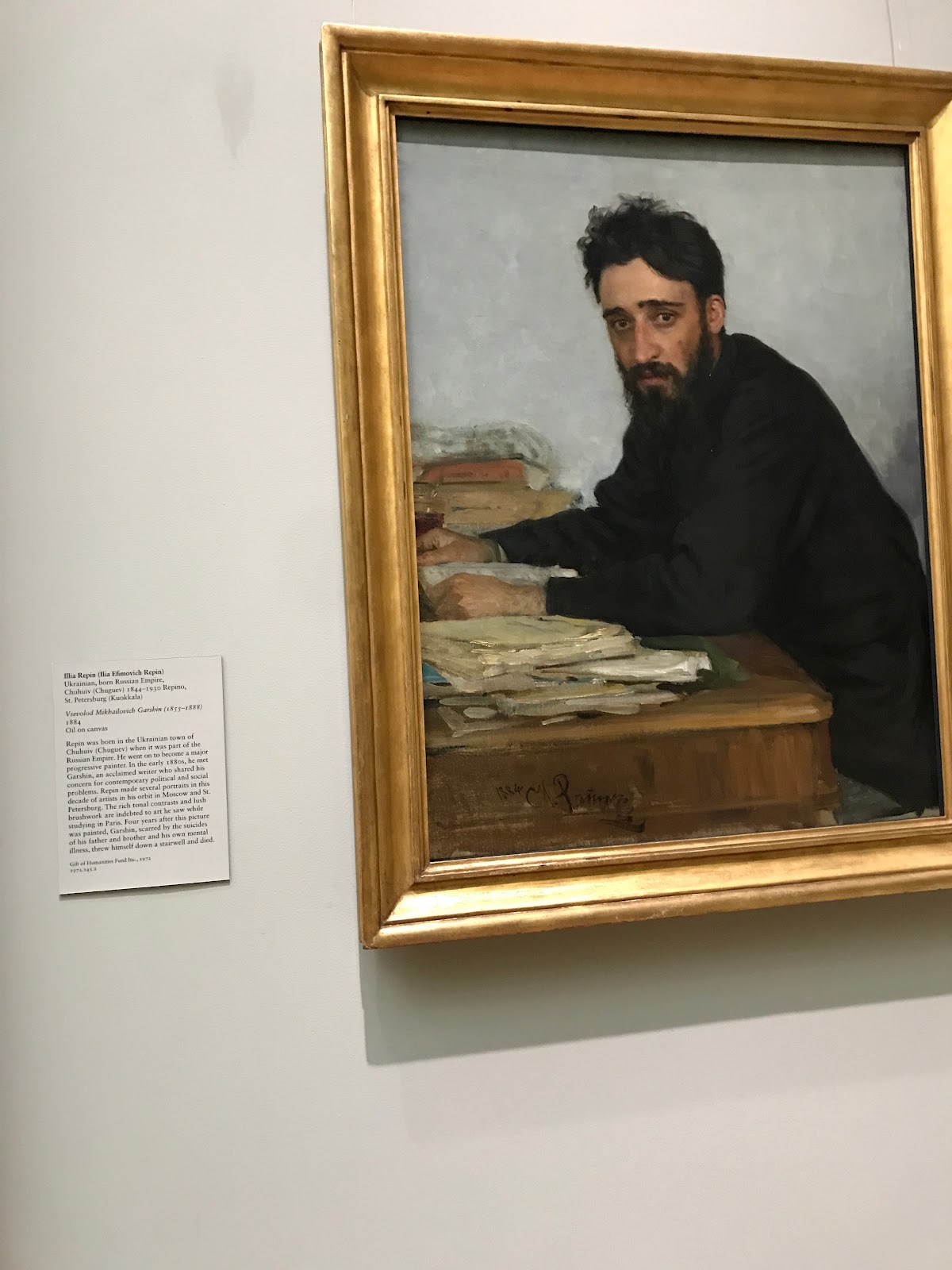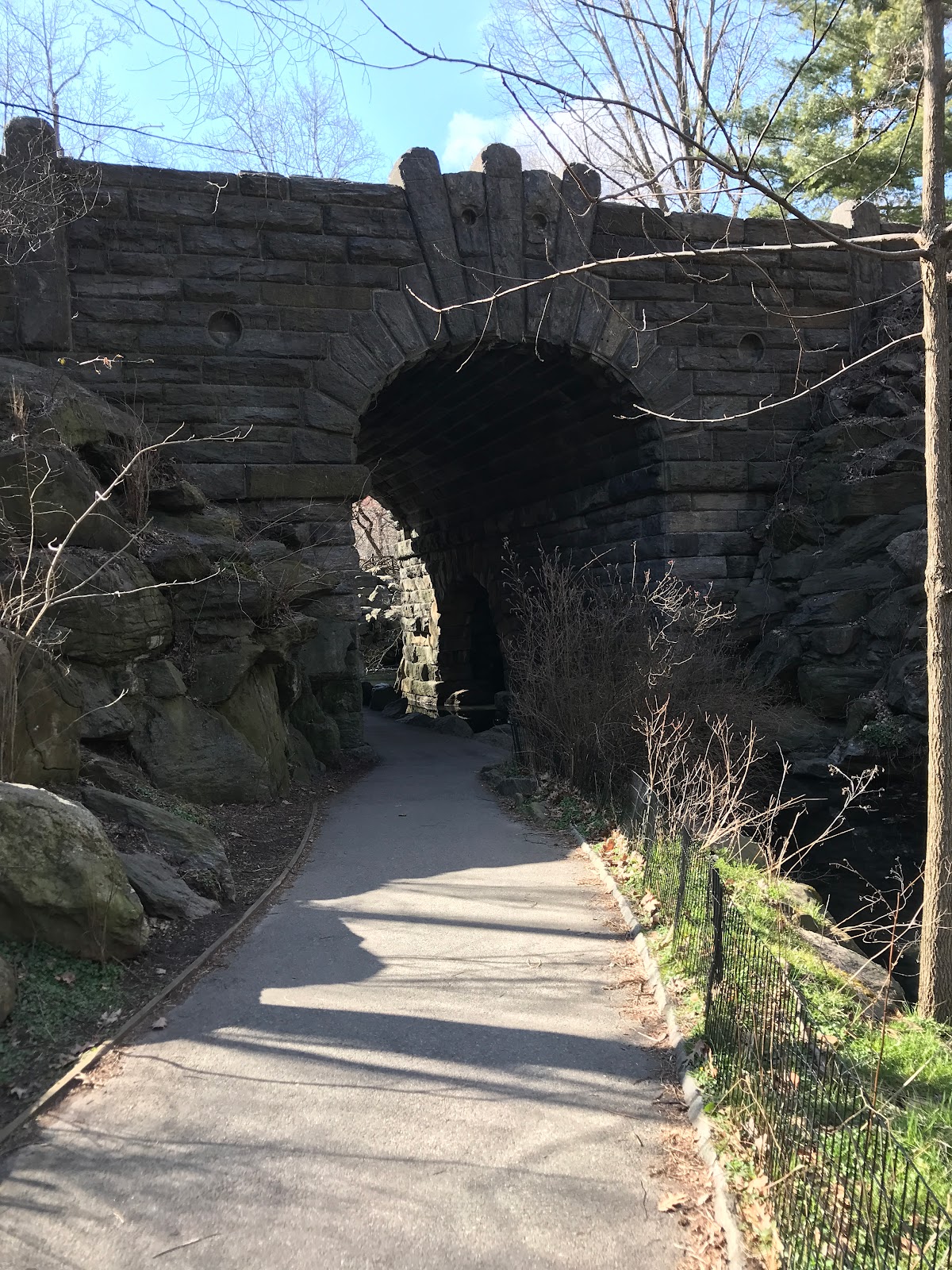I spoke at the Wayne Pres Women's Retreat this weekend (on Transitions) and we used your art cards.The team purchased 100 cards and framed 50 and placed them all around the Chapel for the 50 women in attendance.The frames were double sided, so many women chose two pieces.Your art opened the women to understand, share and articulate what was stirring in them in astonishing ways.I wished you could have seen the emotion, connection, epiphanies...
May 6, 2025
Art Postcards at a Retreat
Apr 28, 2025
Lenten Installation
I learned a lot from doing it, especially that it's risky to paint Jesus! I was a little intimidated about painting Christ, so I copied a portrait that Rembrandt had done of a man in the Jewish ghetto of Amsterdam. The portrait of Christ struck a nerve for a congregant, who explained to me, "I go into many churches that are full of white Jesuses, but they don't bother me because I know my church doesn't do that. So when I saw the Jesus here, I couldn't stop crying." So I climbed a 10' ladder and darkened his skin, but it was still problematic. The person explained that Jesus's posture, hovering from above, felt dominating, and this person was from a tradition that didn't have any images of Christ in the sanctuary. It was a delicate situation, so just in case other people were also having issues with the installation, we had a question and answer time after a service.
I love working on paintings in the privacy of my studio, telling myself that no one will see the finished work except myself, tricking myself to paint honestly. Doing this installation challenged me to dialogue and compromise at times, but I felt like I learned so much and felt a deeper bond with the member who struggled with the piece initially. And I love seeing congregants interact with the piece after the church services.
On Easter Sunday I added a dove.
Mar 16, 2025
It's Going to Be Alright
Today I received this email from a collector named Justin:
Feb 28, 2025
14 Days, 10 Paintings, 2 Cases of Covid
It's my last day at Dorland Mountain Arts Colony. 14 days, 10 paintings, 2 cases of Covid.
I am so grateful for the time here, even with all of its challenges. When there's nothing to do except hike and paint, I paint a lot! Some paintings are stronger than others, but by painting so much is such a short time, some solid pieces will rice to the top.
Thank you, Janice, for facilitating this space. Thanks, too, to Rebecca, Gretchen, Emily and Jeff, for letting me join the sunset gatherings with my mask!
Feb 21, 2025
Two Weeks at Dorland
Dorland Mountain Artist Colony is a cluster of cottages and studios perched on a mountain overlooking Temecula, California. The area is dry desert, but there are hidden springs on this mountain that nourish oaks and ferns. They nourish artists, writers, and musicians as well, who come for a week or more to finish projects or search out new inspiration. It's very quiet here except for crows and coyotes, the hiss of cars on the highway, and occasional helicopters in training at Camp Pendleton.
I'm 11 days into a two week residency, but in some ways it feels like I'm just getting started. I was exposed to Covid before we arrived here and spent four days quarantining until the medicine kicked in. When I was able to paint, I felt intimidated by all of the wood panels that I had brought and wondered if I'd be able to create anything fresh and new with the time I had left.
Fortunately, there is a magic about this place. The high desert landscape feels remote and pristine, in contrast the the lights of Temecula that spread out below. There's not much to do here except hike and paint and perhaps watch the sunsets with the other residents. As I write this, rabbits and blue jays explore outside my window. I am so grateful for the quiet here, and I have no excuses for procrastination, so I am painting all the time.
I've been thinking about the story in the gospels about how Jesus fed 5000 people with a few loaves and fishes that a child brought to him. I look at my paintings here and feel like they are very meager gifts for our troubled world, and that's okay.
Nov 27, 2023
Slowing Down at 80 mph
A road trip is a different type of creative journey. Unlike a residency, where I delve deeply into the quiet and paint without distraction, a road trip is all about distraction.
On October 22, Ed and I headed east with a car loaded with paintings, ice chest, suitcases, and books on CD. Our destination was Denver where my sister and her kids live and I have a small but loyal following of art collectors. We started at Yosemite, where the two main visual themes of the trip began, a fascination with cliffs and tunnels.From there we drove on over the Tioga Pass and down across Nevada on a blue highway, only pausing to let the cattle cross. I continued pursuing cliffs and tunnels at Zion National Park, and then we were on to the Rockies. We got to the Mile High City the day before their first major snow storm of the year, but we we able to make a visit to Denver's Santa Fe art district and connect with some lovely artists there.
I had contacted my Denver collectors before the trip and was able to deliver three paintings and various art postcard orders while I was there. Thanks to everyone who braved the storm and got their art! It was lovely to have time with my sister and her kids and grandkids.
After four nights in Denver, we headed home. We stopped in Manti, Utah for the night, in a fascinating art house, a restored 150 year old cabin with the owner's art studio next door. Then on to Great Basin National Park, Nevada, with the most beautiful hike of the trip at the Bristlecone Pine Trail at 10,000 feet. Too amazing to paint, but I might try. Liz at the Stargazer Motel in Baker, Nevada, made us feel right at home. The next day we set the cruise control at 80 and breezed across Nevada on Highway 50, pausing just for an occasional coyote or jack rabbit or that elusive hot tea and scone.
We did the 3000 trip in 12 days. We wanted to avoid flying as a nod to the effects of air travel on our climate, but as we stood and watched navy fighter places circling over a desert base on our last day on the road, it felt like futility. Does one car on one highway do anything to help the planet? But there was an irony that driving on a lonely road actually slowed me down, gave me fresh eyes, detachment from the Bay Area frenzy. And there were such lovely interactions with people so different from myself--Airbnb hosts at Zion and Manti, my art people in Denver, and my beloved sister and her tribe.
Sep 10, 2023
The Evolution of a Painting
This one started by discovering a 40-year-old canvas of mine in a friend's mother's house. We were there helping our friend to prepare the house for sale after her passing, and I eyed the 48"x60" stretcher bars greedily. Our friend was overwhelmed and was glad to let us take the wooden supports while his brother took the painting. When we got it home (thanks, Brian, for transporting it), we restretched it and I covered it with a pink base coat. We had just been at a friend's wedding, so the bride and cake quickly appeared. Big billowy clouds were soon replaced with the deep greens of a forest.
I fleshed out the darker branches and fussed with the guests.
It felt like they needed a table, and I added a baby being tossed into the air; I didn't want the bride and groom to be the sole focus.
Details of the figures gradually appeared...
They needed a few more chairs, some softenings on the colors...and the painting is done!
Aug 14, 2023
Painting Truth
I recently had this article published in Radix Magazine.
I am an artist living and working in Oakland, California. I live in a 100+-year-old house on a street of old houses lined with dying magnolia trees. My children have grown and left home, although the lure of dinner and the washing machine can entice them back. We have an extra bedroom that we share with a stream of young adults in transition. The latest, a young sailor, sometimes needs a place to anchor when she is studying for her captain’s license, or her money has run out, or she is recovering from a broken heart.
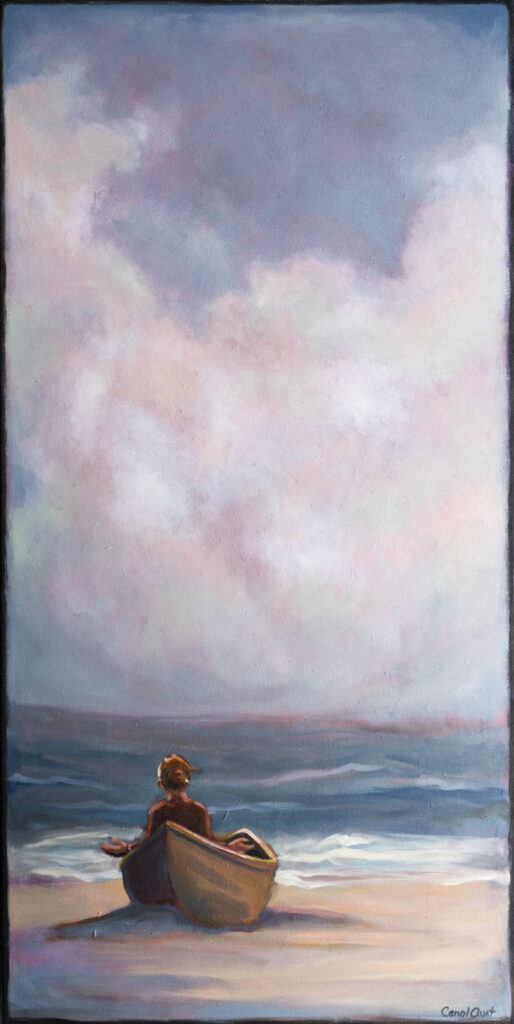
So I paint a woman in a boat on a beach, hands open, no oars. The painting is my prayer for our sailor as she embarks again. Many of my paintings begin as prayers.
Open Hand, acrylics on canvas, 60″x30″
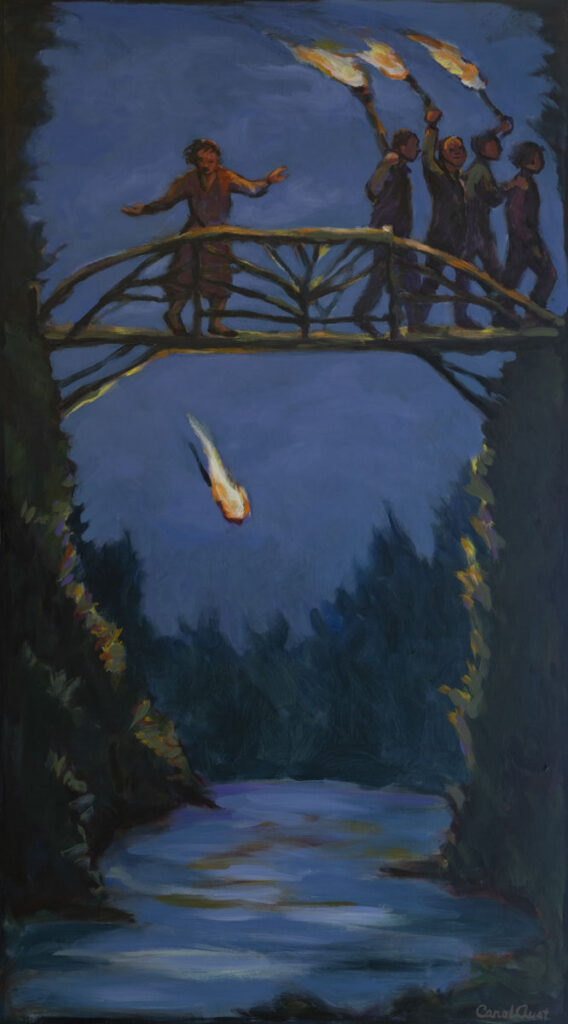
I paint a bridge across a canyon. I paint a woman on the bridge, arms open, eyes averted. It feels too passive, not right. I cover the woman with blue. I paint a woman striding forward. I don’t like that either. I paint a woman dropping her torch behind a night procession. My prayer is that the young adults in my life, my children and my guests, learn to separate from the world’s pressures when they need to.
Bridge in Torchlight, acrylics on panel, 45″x25″
Every afternoon I descend to the basement of my old house, a cup of tea in one hand, a plastic water carton with brushes in the other, to where my studio waits under old redwood beams that creak and moan during occasional earthquakes. Going down to the basement is like descending into my subconscious. In the big dim subterranean space, the lights focus on an easel. When I paint, I become completely absorbed. I step back and look at what I’ve painted, and then I move in close to paint more. The hours fly by.
To counterbalance my studio solitude I volunteer as a tutor with children and young adults, teaching them how to read. Unaccompanied minors, unhoused youth, teen moms from Yemen—it takes a miracle for them to learn how to decipher the words on a page.
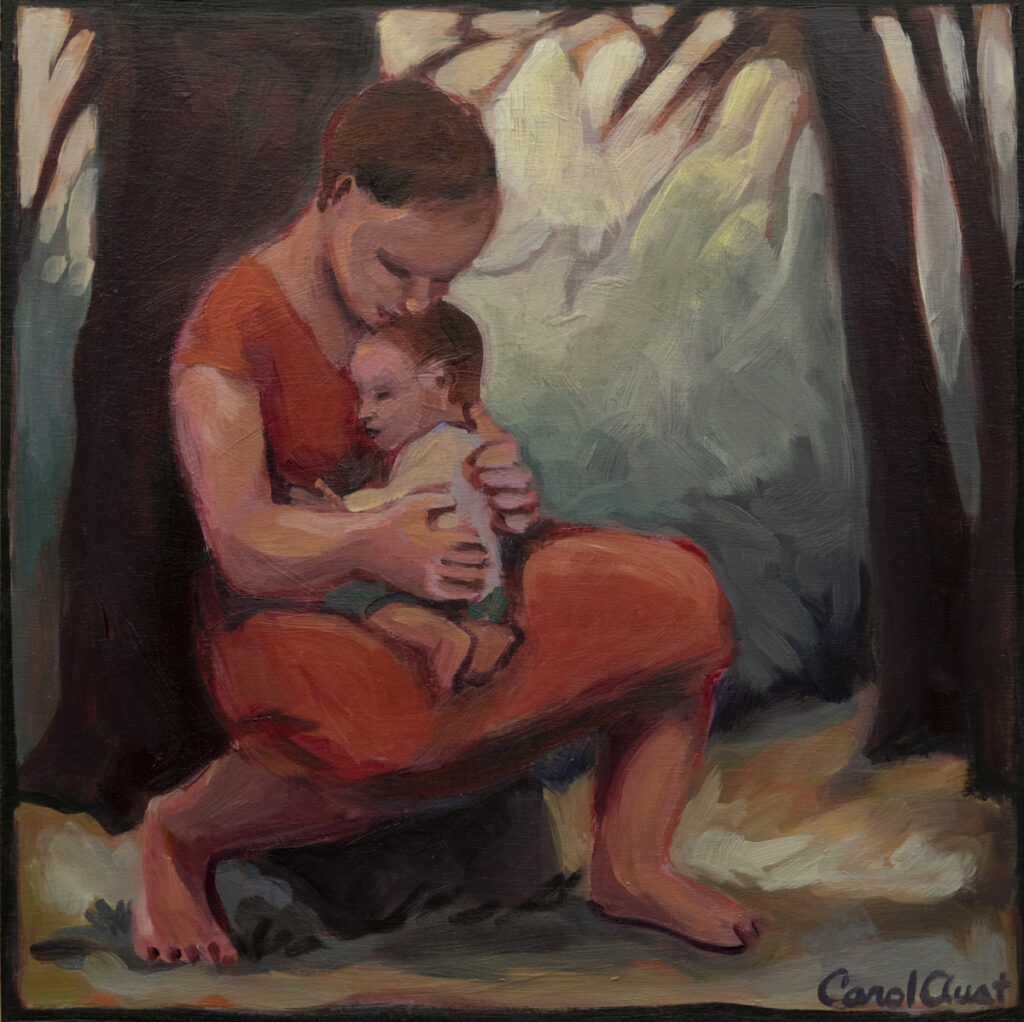
Later in the day, I put another panel on my easel and paint a mother and child, another prayer. As I paint it, I put my students in God’s arms. I rest in God’s arms, too.
Mother and Child #48, acrylics on panel, 14″x14″
There’s a second chapter to the paintings I make. Creating art is like raising children, and just as leaving home is a process, a painting isn’t necessarily finished once I sign the corner. In fact, its life has just begun. When a painting leaves my studio and elicits responses from viewers, the art becomes a living force in the world. Viewers of my work add the next chapter to the unfinished story, explaining why the woman is traveling alone, why the couple is dancing in the clouds, why the party is being held in the desert, what the particular painting means to them.
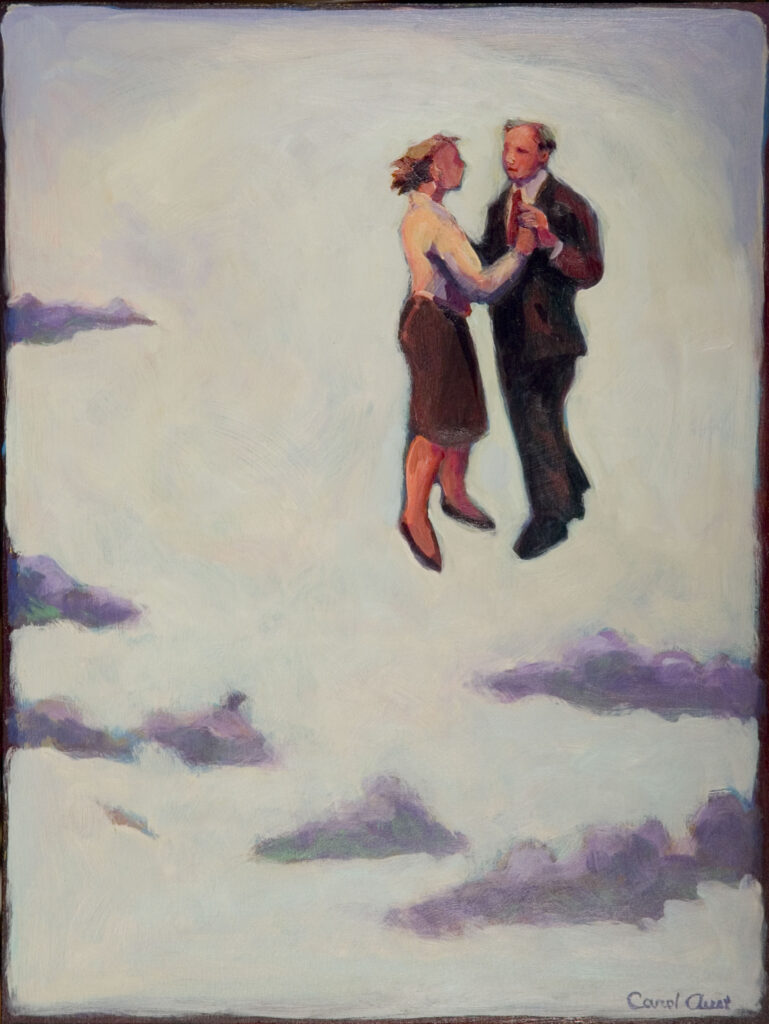
Years ago I painted a couple dancing and floating high among lavender clouds. I titled it No Visible Means of Support and hung it at an open studio. A couple approached me, and the wife said, “We need to have that painting,” gesturing to the dancers. I smiled and reached for my invoice book, but she stopped me and explained, “No, we really need that painting.” So I put the invoice book down and leaned in. She put an arm around her husband. “Mark had cancer this year and we had no visible means of support.” The painting changed and deepened at that moment; it became an instrument of healing.
No Visible Means of Support, acrylics on panel
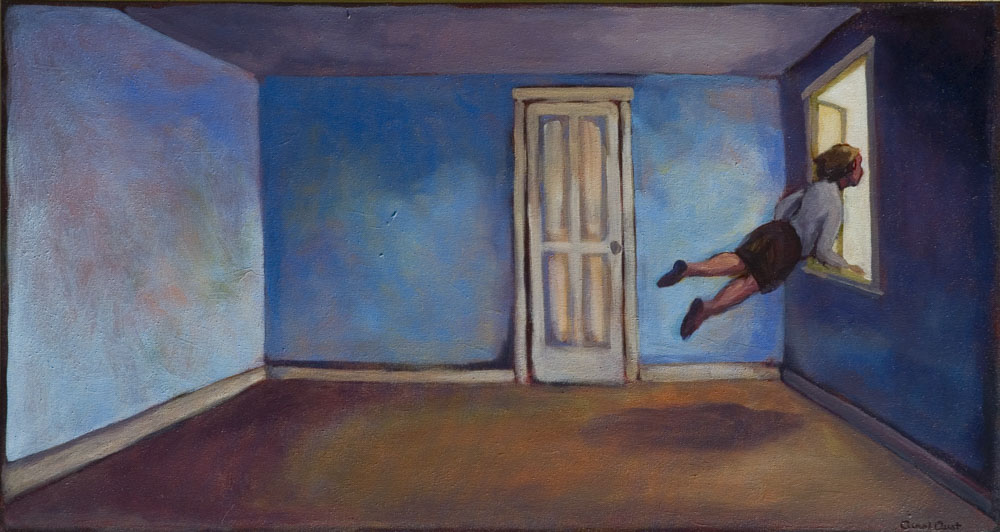
Another time, a woman called me and said, “I want to buy Out the Window, but you’ll need to deliver it to me because I’m in hospice.” I took the painting to a brown bungalow in the East Bay Hills, and someone led me to the living room where the woman who called me was reclining on a sofa. I rested the painting against an armchair, and we sat and looked at it together. It depicted a woman in a blue room, floating out of a window into a white sky. The woman said quietly, “My grandfather died by jumping out of a window after he returned from the war.” I paused and asked her if she wanted me to take it away. She answered, “No. I always thought that when I died I’d go into darkness, but as I look at this I realize I’ll go into light.”
Three weeks later, her friend called me and told me that the woman had died. I offered to take the painting back, but she said, “No, her husband wants to keep it. It comforts him.”
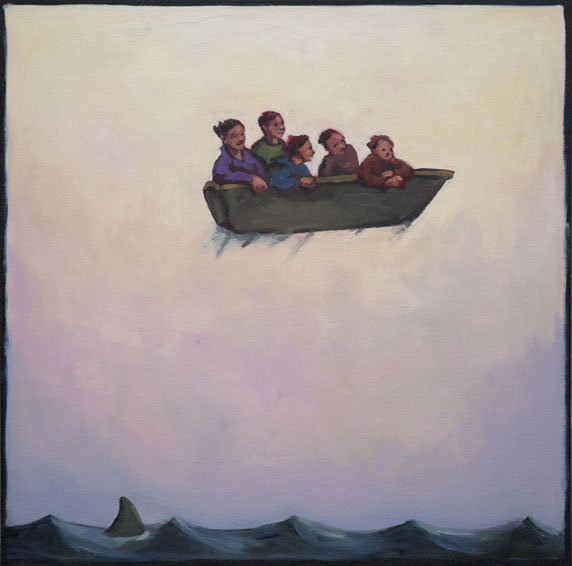
A few months later, a gallery director took some art of mine to a potential client, including a painting of a woman and four children in a flying boat. As she unloaded them in the client’s driveway, the woman gasped and explained that her husband had died suddenly a few years before, leaving her with four children and a large company to run. She took the painting and hung it in her bedroom in order to focus on the strength of the woman in the boat.
No Worries, acrylics on panel, 24″x24″
Often, I don’t hear the stories; I just see the tears. People will apologize as they dab their eyes and say, “I don’t know why I’m crying.” and I’ll respond, “That’s okay. It happens.” I know the art is touching a nerve, bypassing a wall they’ve erected.
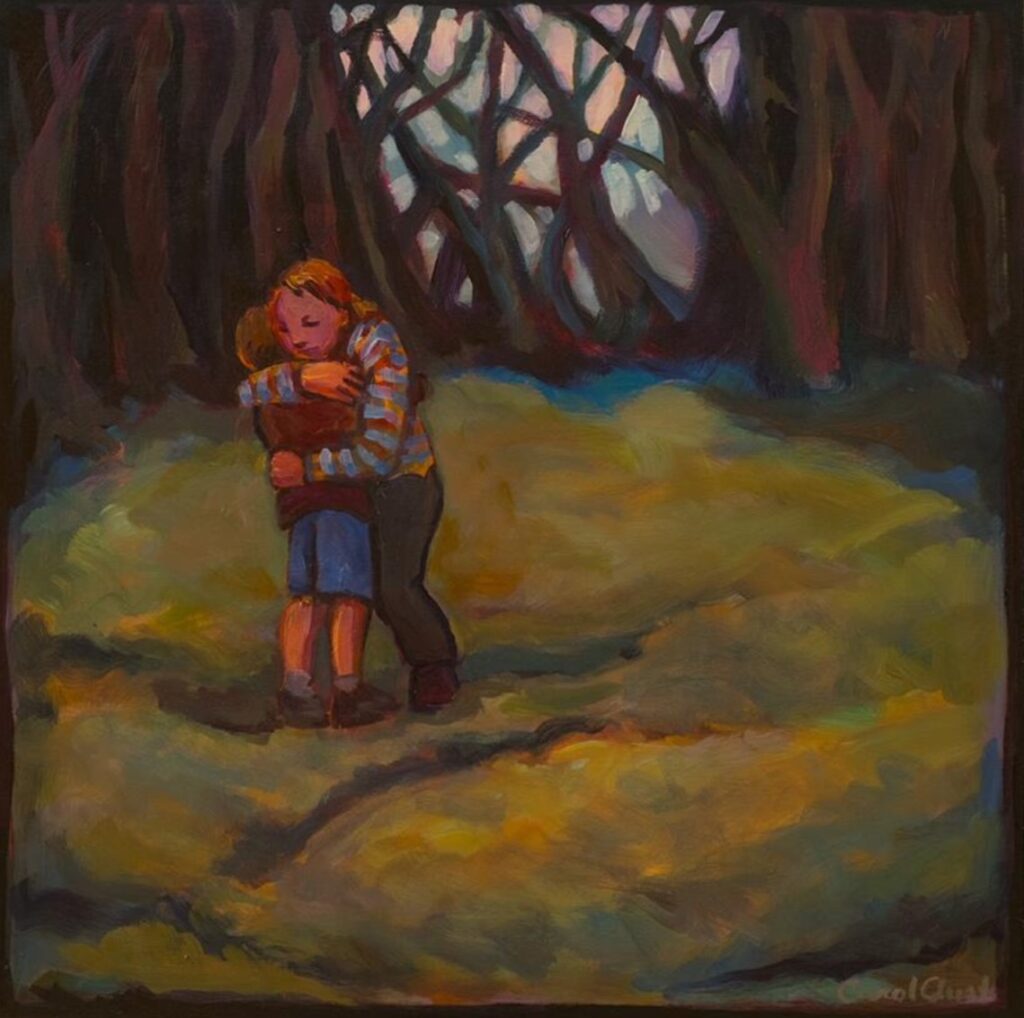
A member of my church bought one of my paintings of a mother hugging a girl at an auction. The next Sunday she explained through tears, “My mother died when I was eight. When I look at that painting I feel like God is holding me.”
Forest Hug, acrylics on canvas, 18″x18″
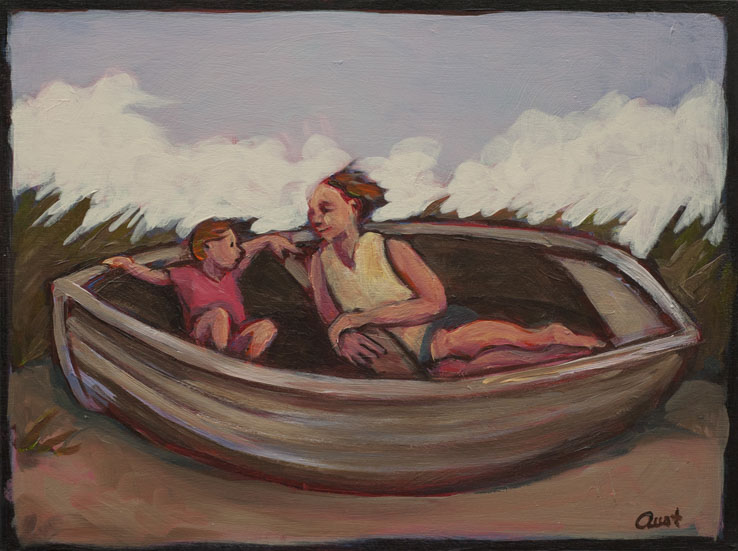
A woman wiped tears as she looked at Tell Me All About It, a picture of a mother listening intently to her child. “My mother listened to me like that,” she explained, and then paused and went on. “I just realized that today is the anniversary of her death.”
Tell Me All About It, acrylics on wood panel, 9″x12″
As an artist, I approach the canvas humbly and honestly. There’s no formula to follow. I’m not consciously trying to evoke emotions in the viewer, and I can never predict what paintings will touch people. Sometimes a piece of art will be unnoticed for years but then hit someone very miraculously. All I know is that if I’m faithful to God in painting my deepest truth, sometimes God uses the art to speak to people. The invisible becomes visible in a way that bypasses language. There’s a mystery here that I don’t understand.
In the dining room of our old house, I often extended the table by wedging an artist panel in the middle. For the five years before Covid, we would unlock our front door every Wednesday evening and put on a big pot of soup or a casserole, and fifteen to twenty-five friends (and an occasional delivery person) would come and dish up, laughing, arguing, and pushing their chairs back to make room as more guests arrived. It feels like a dim memory now. When the pandemic swept through our city and overflowed our hospitals, we kept our doors locked. I begin a new canvas, a canopy of trees with a golden opening in the distance. But what should I put in that archway moving towards the future? I paint a solitary woman carrying a suitcase. But I’ve painted her too many times these past years, so I cover her with pink. I paint a solitary woman on a bicycle, but I paint over her, too. I become so frustrated that I put the canvas away, facing the wall. I feel like a failure, like I’ll never paint anything good again.
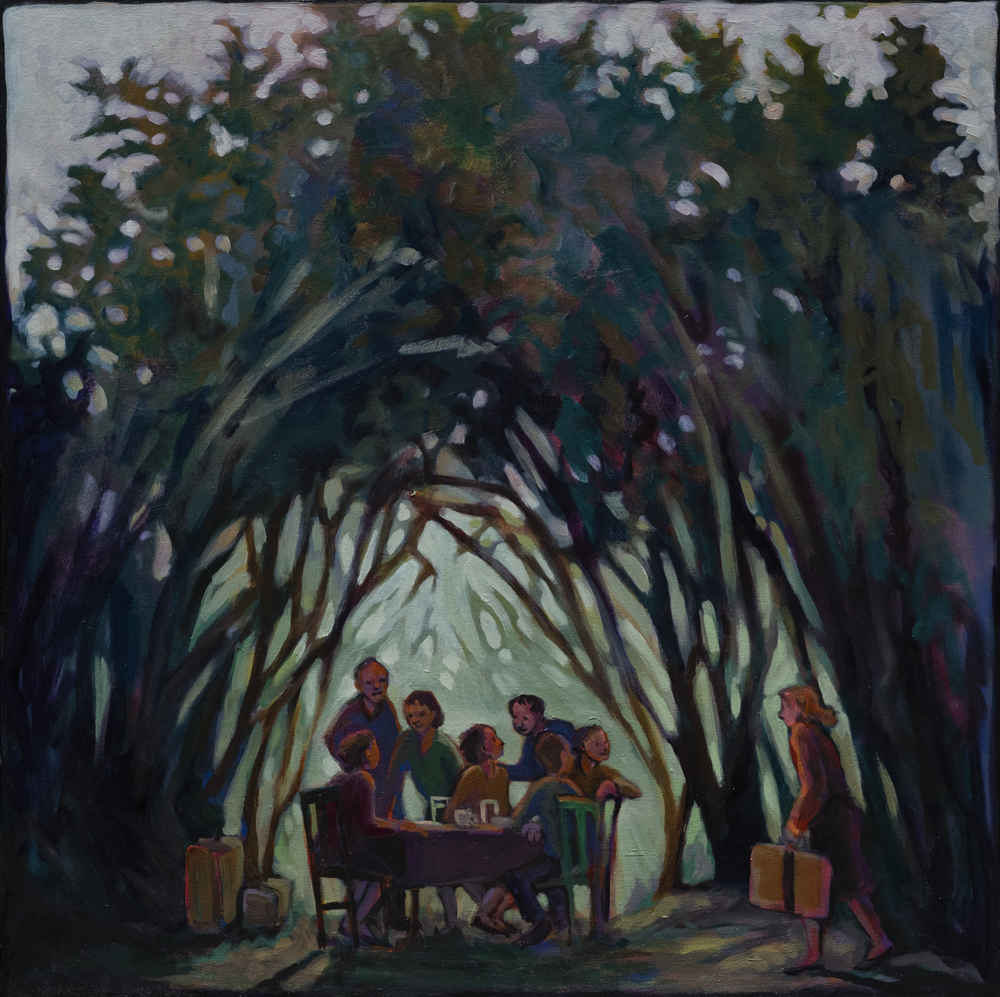
I wait a couple of weeks and pull it out, and then the miracle happens again. I paint a gathering of friends with suitcases piled nearby—not a big group, but one that’s beginning. It’s good enough, and I feel deep relief. But then I have to throw down my brush and run upstairs to start the soup. People are arriving for dinner soon.
Come As You Are, acrylics on canvas, 36″x36″
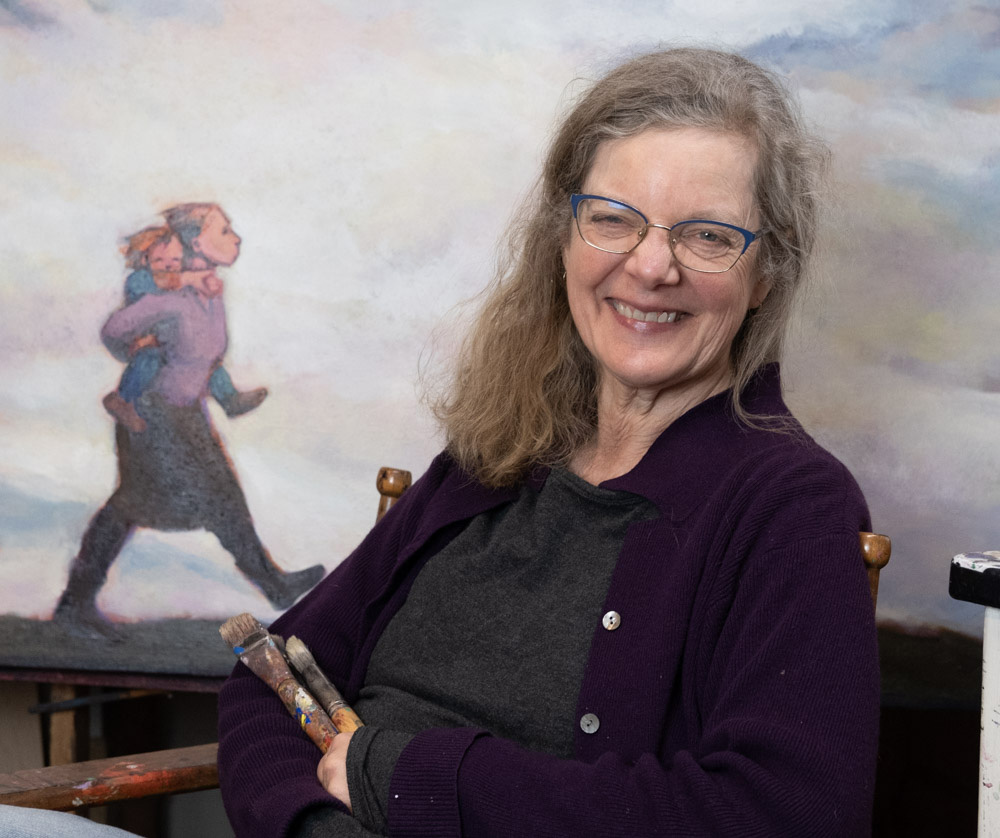
Mar 31, 2023
WPA Art in Washington DC
When I was a girl, my dad would take me and my brother and sister to San Francisco once a year. It was a big event, worthy of white lace anklets and black patent leather shoes. We'd ride cable cars and buy tiny sea shell baskets at Fisherman's Wharf. Then, as the fog rolled in and the neon signs flickered on, we'd walk through North Beach to a cafeteria my dad had liked since college. Across one big wall was a large mural depicting life in the City back in the 1930's, and Dad explained to us that it was a WPA mural. He told us that through the Works Progress Administration during the Depression, the government had paid unemployed artists to do all sorts of projects all over the country, like the murals in Coit Tower and mosaics on the UC Berkeley campus. We went back a few years later and discovered that the mural in the cafeteria had been replaced by large photos. We were indignant.
Ever since then, I've had a special place in my heart for WPA art. Last week in Washington DC, I saw these paintings in the Smithsonian. I love their accessibility, the way they captured real life.
This last painting was done by Matsuaburo George Hibi while he was in an internment camp during World War II. It's entitled "Coyotes Came Out of the Desert".
Mar 22, 2023
The Prowl for New Inspiration
I am in New York right now. I am on the prowl for new inspiration.
It's been a whirlwind. We flew into JFK on Saturday night and were picked up at the curb by our dear friend, Doug, and his daughter, Hannah. They helped us check into our AirBNB in Harlem and then took us out for Thai food.
New York! It's been much too long! Sunday morning we wound our way through Central Park, photographing stone arches for future paintings, and gradually making our way to the Met. It felt so luxurious to have all the time I wanted to get completely lost among so much great art but also be able to find my old favories--Portrait of Madam X by Sargent and this painting by Illia Repin. This started the recurring theme of the art that has grabbed me this week: portraits with intense direct gazes, portraits that transcend time and place.
We started Monday at Cafe Sebarsky and then headed upstairs to see the paintings by Gustav Klimt and Egon Schiele among others at the Neue Galerie. Then on to MoMA, where I sketched notes for future paintings. More wanderings through Central Park for more bridges and arches. Tuesday was our day to hit the galleries in Chelsea, including a show at David Zwirner where Gerard Richter is showing his final paintings. (How does an artist know it's time to put down his brush? What will my final paintings be?) Wednesday we hit the International Center of Photography for a stunning portrait show--more of those direct gazes.This has felt very much like a work trip, just what I need to do to keep my work fresh and strong. Exhausting but important. Tomorrow we will take the train to Washington DC and continue the prowl for new inspiration.Feb 12, 2023
8 Steps to Getting an Out-of-Town Gallery
Getting gallery representation can feel overwhelming, especially when looking for places far from home. I was recently talking with some artist friends about my strategies, and I thought I'd share them here as well.
To get a local gallery, be friendly. Go to their events, and talk with them about the work they show. But if you already have a local gallery or there aren't any galleries in your community, how do you find representation farther away? I've been working with galleries across the country for 20 years, and I've come up with a system that works for me.
- Create a body of work. Put at least 20 paintings, preferably more, on a website. The work must be strong and compelling, images that stop people in their tracks and make them want to take a second look, art that would break your heart a little if they sold. Galleries want to see volume as well so they can know that you will be able to keep them supplied if their collectors get excited and buy the work.
- If you can visit galleries in other towns, that's great, but it's not always possible. In that case, research galleries on-line. Consider second-tier cities or vacation destinations; don't start with New York. Google-search art galleries in a city where you have family or friends and could visit cheaply and where your people could be called on if you suspect funny business once your work is there. (I've called on friends to help me retrieve work when a gallery suddenly closed under Covid.) Visit the websites of artists you admire and see where they're showing; this might open you up to areas you hadn't considered. Type in "art galleries" on Google Maps for a place you'd love to visit. My sweet spot is finding communities 2-5 hours away from where I live, because I can transport the work in a day if need be, without paying for shipping. Keep in mind that what you're looking for are galleries that are showing art that has a commonality with your work but is different in some ways. Perhaps you do monotypes, and they show etchings or screenprints. Or you have a series of nocturnal landscapes, and the gallery shows landscapes but none at night. Don't approach any gallery that says on their website that they're not taking solicitations or that they only show local artists; they'll just be annoyed that you didn't study their website carefully.
- Print a book of your art, a small catalogue of available pieces. I create a 7"x7" paperback on Blurb that has about 30-40 pages. I put my name on the cover and have my contact info on one of the first pages, with a great image and statement after that. After 20-30 images of my work, I include a CV that lists my show history and current representation. I order twenty copies for about $20/piece. (See an example of one of my past books.)
- Create a packet that includes a cover letter, explaining what stood out to you about their gallery and why you thought my work would fit well there. Address the cover letter to the gallery director; if their name isn't on the website, a quick phone call to the venue helps. In the packet include your book, the cover letter, a business card, and a stamped self-addressed envelope. I put all of this in a glassine envelope, arranged so my name on the book cover is visible from the outside.
- Mail it out! I send out as many as 20 packets at a time, and from that I'm happy if I get one nibble. My studio mate thought that was too much; she sent out three packets and got two new galleries at the first crack. Another artist I know printed out 2000 catalogues of her work and shipped them all over the country and Europe. Keep a record of every place you send a packet to, and add to that record every time you email or call the gallery or hear back from them.
- Follow up with an email to the galleries a day or two after the packet arrives. Mention the packet. Include a couple of images of your work, a link to your website, and a phone number.
- If you're feeling especially brave, follow up with a phone call to the gallery. Have an elevator speech prepared, a three minute explanation of your work, just in case they say, "Actually, we just lost an artist and are looking for a figurative painter..." (A gallery told me that once when I did my follow-up call, and I was completely tongue-tied!)
- Celebrate all responses. I print out the rejections and decorate them and put them in a file called "Closed Doors." In my art group, our goal is to get 100 denials, and we all cheer as we add to the tally. But sometimes there's a new gallery relationship.
I have found 13 new galleries to show my work by doing these steps over the years. Some of the relationships lasted only a few years or less; the galleries closed or the work didn't fit with their clientele. But I have continued working with a few of the galleries for eight years or more.
In general, I go through this process every year or two, generally in December or January. Even if a gallery doesn't accept my work, I still feel that it's important to educate galleries concerning what art is being created out in the world. As the books are returned in the stamped, self-addressed envelopes, I send them out again. If I have accomplished my goal of getting new representation, I sell the remaining books at an open studio.
Dec 30, 2022
Postcard Sets
Over the years I have experimented with different ways of making my art accessible to the general public, art appreciators who might not have the wall space or cash for an original painting. I have tried mugs, canvas bags, calendars, and Christmas cards. I also made prints of favorite images. It all resulted in being on a first name basis with my postal clerk, but I never made a profit. Often I lost money, and I still have shelves of Christmas cards. (Just $25 for ten cards!)
Then about six years ago a friend, Cari Jenkins, suggested that I create a set of 50 postcards, each of a different painting. Cari and I were both hosting weekly open table dinners to draw people together, and Cari thought the cards could be community builders.
I selected 50 paintings that depicted very different emotions--couples dancing, women escaping fire, parents embracing children, etc.--and I sent them off to Moo.com for printing. I ordered boxes for each set from U-line, and I printed prompts for using the cards at dinner parties, with team building, in writing classes, for small groups, and for journaling. Some of the prompts include:
For dinner parties:
- Spread the
cards out on the table and invite people to select two or three cards
that appeal to them. Ask them to share with the group why.
- What picture describes a hope you have for the year?
- Is there a picture you have that represents a desire you have for your life?
Journaling prompts:
- Flip through the cards until one catches your attention. Pay attention to what you feel as you liok at it. What memories come to mind? Does it embody what you're feeling about life?
- Lay out the cards in front of you. Is there one that feels like an invitation for the upcoming day or the future?
- Close
your eyes and draw a card at random, and ask God to remind you of one of
his promises. Open your eyes and look at the picture. Is there a
promise that comes to mind? Write about it.
Team building prompts:
- Choose a picture of what it feels like to be a part of this team.
- Choose a picture that depicts what it feels like to come in to work everyday.
- Have each person select a picture that represents someone else on the team. How does that picture best represent the character of that person?
For teachers and writing groups:
- Draw two cards. Write a story base on the two cards from the perspective of one of the figures. Then rewrite the story based on the perspective of the other figure. Combine the stories with only quoted dialogue, no descriptions.
- Draw three cards.Write a story. Next, write a completely different story based on the same three cards.
- Draw a card. Write a monologue in which one of the characters talks about things s/he has done in the past and will do in the future.
For Christian small groups:
- Choose a picture that best describes how you are feeling in relationship with others.
- Choose a picture that describes what you think about God.
- Choose a picture that best describes what you need from Jesus today or this year.
I posted the postcard sets on-line and set them out at open studios, and they have a growing following. It has been an idea that has stuck. Word has spread primarily via word of mouth. They have sold all over the USA, and I've gotten feedback from as far away as Kenya and Australia. Someone in Bolivia is using them with women who have been sexually abused. Based on popular demand, I made a second set two years ago. I ship out a steady stream of boxes throughout the year and continue to be on a first name basis with my postal clerk. This year I hope to make a third set.
A heads-up to other artists who might consider doing this--these are not a big money-maker. I am breaking even, but I primarily sell the cards because it feels good to have the images out in the world and communicating. It's especially poignant for me to be able to revisit paintings that have sold.
The cards are available for $39.25 if you order them on-line or $30 if you pick them up at my home in Oakland, Ca. Prompts are available for free upon request. To order, go to carolaust.com/carol/content/postcards . If you do not want to do PayPal, you can mail a check to Carol Aust, 655 63rd St., Oakland, Ca, 94609. And if you have any questions, email me at carol.aust.art@gmail.com.
Dec 13, 2022
Five Tips for Hosting an Art Salon
We have hosted many art salons over the years. These have always been a little funkier than the slick salons posted on-line with women in pencil-thin dresses in vast New York lofts, and I don't think Gertrude Stein would see much similarity with her Parisian salons. Ours have always been held at our home with any and everyone on my mailing list invited for an evening of sharing what they've done creatively.
My favorite salon story concerns a dear friend who bought a new date to our salon, and when their turn came to share, we pushed aside the dining room table, and they danced a sultry tango to a recorded song. At the end of the evening, his date shyly asked to buy a romantic painting of a dancing couple, and a year later, another of my dance paintings was on their wedding program.
Last Sunday evening we hosted our first post-Covid art salon. Unlike our gatherings from 4 or 5 years ago when the house was bursting at the seams, this one was a sedate 13 people, but everyone here seemed to realize how wonderful it was to be together and sharing after years of isolation.
As an artist, I increasingly feel that relationships are as valuable or more so than art objects. Art is a precious way to bring people together. Our world right now is so thirsty for connection and a chance to embrace creativity.
If you are interested in hosting an art salon, here are a few how-to's:
- Cast your net widely--make repeated invitations on Instagram and Facebook and even send out postcards as well as personal invitations to friends. Explain that everyone is welcome to bring food to share as well as a song or poem or story or visual art piece or dance to share. Request RSVP's by a deadline a few days prior, but hold that lightly and welcome everyone.
- Start with a potluck dinner so people can get acquainted.
- Gather and give each person a chance for a brief introduction, noting who has something that they've created. Explain that after introductions, you will set a timer for maybe 10 minutes per person who has brought something to share. If the group is larger that 15 people, split it into two smaller groups, if you have an extra room available.
- If there's time, let people ask questions or make comments after each creative has shared. Applaud each participant!
- Have a mingling/networking time at the end. Keep your feelers out for people who feel ready for more community, who might want to be in a new critique or writer's group. My latest Get Out the Art Group spun off from a couple of salons.
Nov 29, 2022
8 Strategies for Overcoming Creative Block
I wrestle a lot with creative block. When I'm going through it, I feel like a failure. I procrastinate and am hyper-critical of what I paint. I am the queen of creative block, but there are a few things I do that help.
The hardest part can be just getting to the studio. Reserving the time to create is hard! Sometimes I just go to the studio and clean.
Draw every day. Draw on scraps of paper and old envelopes. Draw when you're waiting for an appointment or for a friend. Draw at church or at concerts or plays.
As a child, I couldn't leave the dinner table until I had eaten everything on my plate (which resulted in many late nights, eyeing a slab of cold liver). I sometimes harness the waste-not-want-not maxim by filling my palette with all sorts of colors and not leaving until the paint is all used up.
Put a microphone to the negative voices in your head. On a scrap of paper, write down the lies, the negative put-downs from people in the distant or recent past, the ragings of an internal monitor. Then next to the lies, write down the truths. My list might include, "My best work is all behind me," and my response: "God will guide my brush."
I need to remember that I am more than what I make; I am not earning my salvation here. I am a beloved child of God, and my work is as unique as my fingerprint. It helps to tell myself sometimes that what I'm creating right now is for my eyes only. I love this quote by Phoebe Waller-Bridge about writing: "Whenever I get stuck on something, I'm like, 'What would I do if I wasn't afraid? What would I write if I wasn't afraid? What would I say in this situation if I wasn't afraid?'"I think the same applies to the visual arts.
Be around creative people who make it seem normal. In 1985, I went to a
Bruce Cockburn concert that changed the trajectory of my life. The music
was great, yes, but more than that was seeing the performer on stage
just being himself without apology, being creative in a unique way that
only he could be. I felt the permission that night to find my own road,
to let go of the pressures to conform and please others.
Another tip for creative block: move your body. Crank up the music and dance in the studio. And then do crazy psychedelic base coats with big brushes and long strokes. And then paint over them, but let a little of their energy peek through.
Or paint pink.
Nov 20, 2022
Why Art?
People who know me well know that I wrestle with this question--why, in this broken world, should people continue creating visual art and music and dance and poetry? I spend three mornings a week teaching children and young adults how to read; isn't that more important?
My answer is that the world needs both. The world needs radical acts of service, and the world also need art. Here are a few reasons why creative acts are so vital:
For beauty
One day years ago I was stuck in heavy traffic on Telegraph Ave. in Berkeley. It was a hot day, and my car window was down. Just then a street musician began playing a beautiful melody on the flute. I was transported. At that time I was working full-time as a teacher, but the beauty of that song made it possible for me to serve another day.
When I wake up in the morning, this painting is the first thing I see:
For community
Art draws people together. My roommate is struggling with chronic pain and a deadening job, but when she plays music with friends, she's transformed. Her laughter joins in with the melodies.
For the prophetic voice
This painting is hanging in an environmental law office. The person who bought it said it was to remind her staff of what they are fighting for.
A hospice patient looked at this painting and told me, "I always thought I'd go into darkness when I died, but when I look at this I realize that I'll go into light."
Sometimes when I create a painting, I don't realize its full significance until it goes out into the world.
For the joy of creating
I bristle at the label of "consumer."
I am the most completely myself when I am creating. Even if what we make is never seen or heard or read by the world, the act of creating makes the world a better place.



























